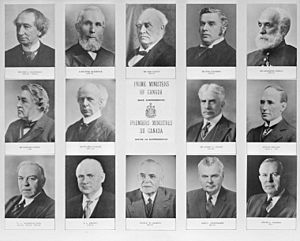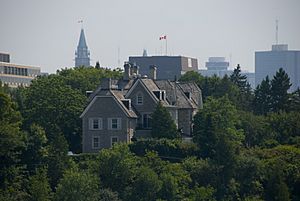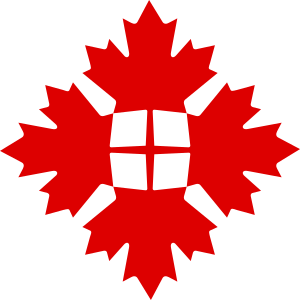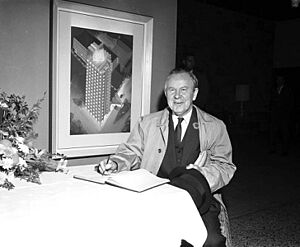Prime Minister of Canada facts for kids
Quick facts for kids Prime Minister of Canada |
|
|---|---|
| Government of Canada Privy Council Office |
|
| Style |
|
| Abbreviation | PM |
| Member of | |
| Reports to | House of Commons |
| Residence | 24 Sussex Drive Rideau Cottage (acting, since 2015) |
| Seat | Office of the Prime Minister and Privy Council building |
| Appointer | Monarch (represented by the governor general)
with the confidence of the House of Commons
|
| Term length | At His Majesty's pleasure |
| Constituting instrument | None (constitutional convention) |
| Inaugural holder | John A. Macdonald |
| Formation | July 1, 1867 |
| Deputy | Deputy Prime Minister |
| Salary | CA$419,600 (2025) |
The prime minister of Canada is the main leader of Canada's government. In Canada's system, the prime minister needs the support of most elected members in the House of Commons. This means the prime minister is usually a Member of Parliament (MP). They also lead the political party with the most seats or a group of parties working together.
The prime minister chooses other ministers to form the Cabinet. The Cabinet helps make important decisions for the country. The prime minister is officially appointed by the governor general. The governor general represents the King or Queen of Canada, who is the head of state.
Even though the King or Queen is the head of state, the prime minister and Cabinet usually make the real decisions. Canadian prime ministers are given a special title, "The Right Honourable", which they keep for life.
The prime minister gets help from the Prime Minister's Office. They also lead the Privy Council Office, which supports the Cabinet. The prime minister also suggests who should be appointed to many important roles. These include the governor general, senators, and judges for the Supreme Court of Canada.
Mark Carney is the current prime minister of Canada. He took office on March 14, 2025. Since Canada became a country in 1867, there have been 24 prime ministers.
Contents
How the Prime Minister's Job Started
The job of prime minister is not written down in Canada's main rule books, like the Constitution Act, 1982. Instead, this job and its duties follow old traditions and rules. These rules are similar to how the prime minister's job works in the United Kingdom.
Becoming Prime Minister: How it Works
Many Canadians think they vote directly for the prime minister. But actually, the prime minister is chosen by the governor general. The governor general picks the person most likely to have the support of the majority of elected members in the House of Commons.
This person is usually the leader of the political party that wins the most seats in an election. Sometimes, it's the leader of a group of parties that work together. There's no special document needed for the appointment; it's usually done by talking.
A prime minister who decides to step down might suggest who should be the next prime minister. However, if they are resigning because they lost support, the governor general doesn't have to follow that advice.
It's not a strict rule that the prime minister must be an MP. But for practical reasons, they are expected to become an MP very quickly. In the past, two prime ministers, John Joseph Caldwell Abbott and Mackenzie Bowell, served while they were members of the Senate.
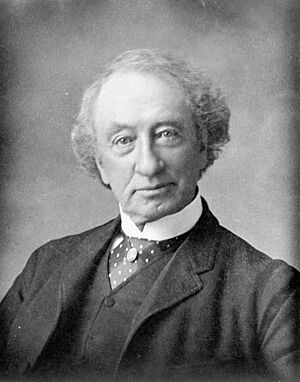
If a prime minister is not an MP when appointed, they are expected to run for a seat in the House of Commons soon. For example, William Lyon Mackenzie King lost his seat in two elections. But he still led the government briefly before winning a special election a few weeks later.
When a prime minister loses their seat, or a new prime minister is chosen without a seat, an MP from their party often steps down. This allows the prime minister to run in a special election for that seat. This seat is usually one that the party is very likely to win.
How Long Does a Prime Minister Serve?
A prime minister serves "at His Majesty's pleasure". This means there is no set time limit for their job. Once appointed, they stay in office until they resign, are removed, or pass away.
Normally, a Canadian Parliament can last up to five years. However, a law passed in 2007 set elections for every four years. The election day is usually the third Monday in October. But the governor general can still call an election earlier if the prime minister asks.
If the prime minister's party wins most seats in an election, they continue their job without being re-appointed. If another party wins most seats, the prime minister might resign. Or they might try to keep the support of the House of Commons.
If no party wins a majority, the prime minister can try to work with other parties. They might form a coalition or make an agreement to get support for their plans.
What Does the Prime Minister Do?
The prime minister is the most powerful person in the Canadian government. They are the head of government. They advise the King or Queen on how to use many of their powers.
Today, the prime minister's advice is almost always followed. This means the prime minister effectively carries out the duties of the King or Queen. The King or Queen and governor general mostly perform ceremonial duties.
The prime minister, with help from the Prime Minister's Office (PMO), chooses many important people. These include the governor general, Cabinet members, and judges. They also choose senators and ambassadors.
The prime minister also plays a big role in making laws. Most new laws that go before Parliament start in the Cabinet.
Some experts say that the prime minister's power has grown a lot. They argue that the prime minister's office has become very strong. This has led some to say the prime minister's role is becoming more like a president.
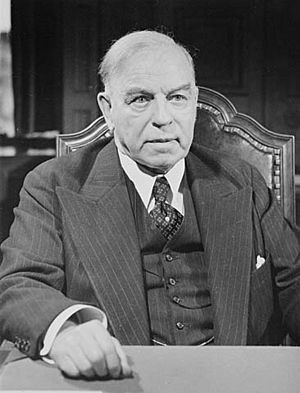
However, there are ways to check the prime minister's power. The House of Commons can vote to remove their support for the prime minister. Also, members of the prime minister's own party can challenge their leadership. This can sometimes force a prime minister to resign.
The Senate can also delay or stop laws proposed by the Cabinet. Canada is a federal country, meaning power is shared between the federal government and provinces. This limits what the prime minister can do.
The King or Queen, or the governor general, can also act against the prime minister's wishes in very serious situations. Former governor general Adrienne Clarkson said she had the right to "encourage, to advise, and to warn" the prime minister.
Special Benefits for Prime Ministers
The prime minister has two official homes. One is 24 Sussex Drive in Ottawa. The other is Harrington Lake, a country retreat. They also have an office in the Office of the Prime Minister and Privy Council building.
For travel, the prime minister has an armored car. They also share two official aircraft: a large plane for international flights and a smaller one for trips within Canada. The Royal Canadian Mounted Police provide constant personal security for the prime minister and their family.
As of April 2024, the prime minister's yearly salary is $406,200. This includes their salary as an MP and an extra salary for being prime minister.
When a prime minister passes away, they usually have a state funeral. Their casket lies in state in the Parliament building.
Before 1919, it was common for the King or Queen to make new Canadian prime ministers knights. This is why some early prime ministers had "Sir" before their names. However, after 1919, Canada decided that Canadians should not receive British noble titles.
The Canadian Heraldic Authority can grant former prime ministers a special symbol on their coat of arms. This symbol is called the "mark of the Prime Ministership of Canada." It has four red maple leaves joined together on a white background.
How to Address the Prime Minister
When speaking directly to the prime minister, people use the title "Prime Minister." In official writing, their full title is used: "The Right Honourable [name], [post-nominal letters], Prime Minister of Canada."
In the House of Commons, other MPs might call the prime minister "the Right Honourable Member for [prime minister's riding]" or "the Right Honourable Prime Minister." Former prime ministers keep the title "the Right Honourable" for the rest of their lives.
In the early days of Canada, the prime minister was sometimes called "Premier of Canada." But today, the federal leader is almost always called the "prime minister." The leaders of Canada's provinces and territories are called "premiers."
What Former Prime Ministers Do
After leaving office, former prime ministers of Canada have done many different things. Some stayed in politics. Others became leaders of the Official Opposition. Some, like John A. Macdonald and Pierre Trudeau, even became prime minister again.
Many former prime ministers returned to private life. For example, Robert Borden became the head of two universities. Lester B. Pearson also became a university head. Joe Clark and Kim Campbell taught at universities.
Former prime ministers often write books about their lives or their time in office.
See also
 In Spanish: Primer ministro de Canadá para niños
In Spanish: Primer ministro de Canadá para niños
- List of prime ministers of Canada
- List of prime ministers of Canada by time in office
- Spouse of the prime minister of Canada



